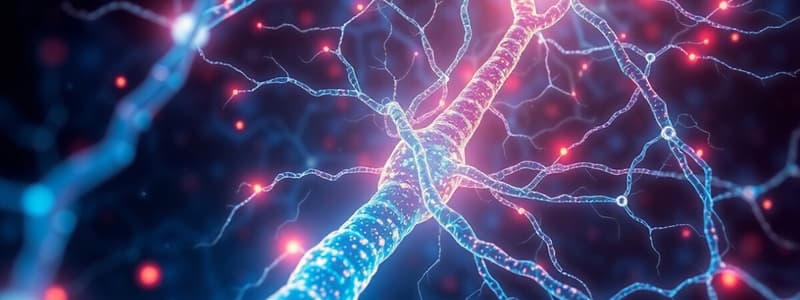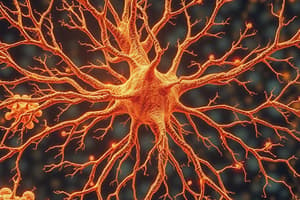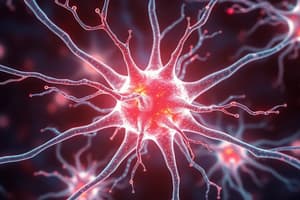Podcast
Questions and Answers
What are the three primary functions of the nervous system?
What are the three primary functions of the nervous system?
- Sensory, Motor, and Digestive
- Motor, Cognitive, and Sensory
- Sensory, Integrative, and Motor (correct)
- Sensory, Integrative, and Homeostatic
What is the term for the electrical signal conducted by neurons?
What is the term for the electrical signal conducted by neurons?
- Action potential (correct)
- Neural wave
- Nerve impulse
- Signal potential
Which branch of the nervous system is responsible for analyzing incoming sensory information?
Which branch of the nervous system is responsible for analyzing incoming sensory information?
- Voluntary
- Sensory
- Integrative (correct)
- Motor
Which type of cell in nervous tissue is responsible for support and protection?
Which type of cell in nervous tissue is responsible for support and protection?
What does the sensory function of the nervous system primarily involve?
What does the sensory function of the nervous system primarily involve?
Which of the following best describes a neuron?
Which of the following best describes a neuron?
What is the main purpose of the nervous system in maintaining health?
What is the main purpose of the nervous system in maintaining health?
How do effectors function in the nervous system?
How do effectors function in the nervous system?
What is the primary function of Action Potentials in excitable cells?
What is the primary function of Action Potentials in excitable cells?
Which type of ion channel is most prevalent in neurons?
Which type of ion channel is most prevalent in neurons?
Which type of ion channel responds to changes in membrane potential?
Which type of ion channel responds to changes in membrane potential?
What characterizes Graded Potentials in comparison to Action Potentials?
What characterizes Graded Potentials in comparison to Action Potentials?
What is a characteristic function of Ligand-gated channels?
What is a characteristic function of Ligand-gated channels?
Leak channels are characterized by which of the following?
Leak channels are characterized by which of the following?
Which of the following statements about resting membrane potential is true?
Which of the following statements about resting membrane potential is true?
Which type of stimuli do Mechanically-gated channels react to?
Which type of stimuli do Mechanically-gated channels react to?
What primarily determines the amplitude of a graded potential?
What primarily determines the amplitude of a graded potential?
What is the main characteristic of graded potentials compared to action potentials?
What is the main characteristic of graded potentials compared to action potentials?
Which phase of an action potential involves the membrane potential becoming more negative?
Which phase of an action potential involves the membrane potential becoming more negative?
What must occur for an action potential to be generated?
What must occur for an action potential to be generated?
Which type of channels are primarily involved in the conduction of action potentials?
Which type of channels are primarily involved in the conduction of action potentials?
How do graded potentials differ in their propagation compared to action potentials?
How do graded potentials differ in their propagation compared to action potentials?
During which phase of an action potential does the membrane potential increase rapidly?
During which phase of an action potential does the membrane potential increase rapidly?
What is one major feature of action potentials compared to graded potentials?
What is one major feature of action potentials compared to graded potentials?
What is necessary for repair to occur in the peripheral nervous system (PNS)?
What is necessary for repair to occur in the peripheral nervous system (PNS)?
Which step is NOT involved in the repair process in the PNS?
Which step is NOT involved in the repair process in the PNS?
What is a common symptom of multiple sclerosis?
What is a common symptom of multiple sclerosis?
What is a common treatment for depression?
What is a common treatment for depression?
Which type of depression is characterized by recurring episodes of mania and depression?
Which type of depression is characterized by recurring episodes of mania and depression?
What causes excitotoxicity in the CNS?
What causes excitotoxicity in the CNS?
What defines epilepsy?
What defines epilepsy?
What type of depression is persistent but less severe than major depression?
What type of depression is persistent but less severe than major depression?
What is the typical amplitude range of action potentials?
What is the typical amplitude range of action potentials?
Which factors contribute to the speed of action potential propagation?
Which factors contribute to the speed of action potential propagation?
How does the duration of graded potentials compare to that of nerve impulses?
How does the duration of graded potentials compare to that of nerve impulses?
What distinguishes action potentials from graded potentials regarding polarity?
What distinguishes action potentials from graded potentials regarding polarity?
Which statement best describes refractory periods in graded potentials?
Which statement best describes refractory periods in graded potentials?
How does myelination affect action potential propagation?
How does myelination affect action potential propagation?
What occurs to action potentials as they propagate along a neuron?
What occurs to action potentials as they propagate along a neuron?
Which of the following statements is true regarding the duration of nerve impulses?
Which of the following statements is true regarding the duration of nerve impulses?
What triggers ligand-gated channels to open?
What triggers ligand-gated channels to open?
Which type of neurons primarily contains voltage-gated channels?
Which type of neurons primarily contains voltage-gated channels?
What is the state of the membrane potential of a non-conducting neuron?
What is the state of the membrane potential of a non-conducting neuron?
What maintains the resting membrane potential in neurons?
What maintains the resting membrane potential in neurons?
Which types of stimuli can open mechanically gated channels?
Which types of stimuli can open mechanically gated channels?
Which statement best describes graded potentials?
Which statement best describes graded potentials?
Which ions are primarily responsible for determining the resting membrane potential?
Which ions are primarily responsible for determining the resting membrane potential?
What effect do most anions have on the intracellular environment of a neuron?
What effect do most anions have on the intracellular environment of a neuron?
Flashcards
What is the main function of the nervous system?
What is the main function of the nervous system?
The nervous system is responsible for detecting changes in the environment, processing this information, and responding to it.
How is the nervous system organized?
How is the nervous system organized?
The nervous system is divided into the central nervous system (CNS) and the peripheral nervous system (PNS).
What does the central nervous system consist of?
What does the central nervous system consist of?
The central nervous system (CNS) consists of the brain and spinal cord.
What does the peripheral nervous system consist of?
What does the peripheral nervous system consist of?
Signup and view all the flashcards
How is the PNS subdivided?
How is the PNS subdivided?
Signup and view all the flashcards
What are neurons?
What are neurons?
Signup and view all the flashcards
What are neuroglia?
What are neuroglia?
Signup and view all the flashcards
What are action potentials?
What are action potentials?
Signup and view all the flashcards
Communication in Excitable Cells
Communication in Excitable Cells
Signup and view all the flashcards
Resting Membrane Potential
Resting Membrane Potential
Signup and view all the flashcards
What are Graded Potentials?
What are Graded Potentials?
Signup and view all the flashcards
Leak Channels
Leak Channels
Signup and view all the flashcards
Ligand-gated Channels
Ligand-gated Channels
Signup and view all the flashcards
Mechanically-gated Channels
Mechanically-gated Channels
Signup and view all the flashcards
Voltage-gated Channels
Voltage-gated Channels
Signup and view all the flashcards
Graded Potential
Graded Potential
Signup and view all the flashcards
Action Potential
Action Potential
Signup and view all the flashcards
Propagation of Action Potentials
Propagation of Action Potentials
Signup and view all the flashcards
Continuous Conduction
Continuous Conduction
Signup and view all the flashcards
Saltatory Conduction
Saltatory Conduction
Signup and view all the flashcards
Propagation Speed
Propagation Speed
Signup and view all the flashcards
Synapse
Synapse
Signup and view all the flashcards
Neurotransmitter
Neurotransmitter
Signup and view all the flashcards
Voltage Difference
Voltage Difference
Signup and view all the flashcards
Factors Affecting Resting Membrane Potential
Factors Affecting Resting Membrane Potential
Signup and view all the flashcards
How Graded Potentials are Generated
How Graded Potentials are Generated
Signup and view all the flashcards
Graded Potential Amplitude
Graded Potential Amplitude
Signup and view all the flashcards
Graded Potential Summation
Graded Potential Summation
Signup and view all the flashcards
Depolarization
Depolarization
Signup and view all the flashcards
Repolarization
Repolarization
Signup and view all the flashcards
Action Potential Threshold
Action Potential Threshold
Signup and view all the flashcards
Sodium Channel Opening (Action Potential)
Sodium Channel Opening (Action Potential)
Signup and view all the flashcards
Potassium Channel Opening (Action Potential)
Potassium Channel Opening (Action Potential)
Signup and view all the flashcards
Peripheral nerve repair
Peripheral nerve repair
Signup and view all the flashcards
Chromatolysis
Chromatolysis
Signup and view all the flashcards
Wallerian degeneration
Wallerian degeneration
Signup and view all the flashcards
Regeneration tube
Regeneration tube
Signup and view all the flashcards
Multiple Sclerosis (MS)
Multiple Sclerosis (MS)
Signup and view all the flashcards
Depression
Depression
Signup and view all the flashcards
Epilepsy
Epilepsy
Signup and view all the flashcards
Excitotoxicity
Excitotoxicity
Signup and view all the flashcards
Study Notes
Nervous Tissue Overview
- The nervous system maintains homeostasis by controlling conditions within healthy limits.
- The nervous system has various branches and cell types.
- The chapter aims to detail the structure and function of nervous tissue.
Nervous System Overview
- Neurons are electrically excitable cells.
- Nervous impulses travel in specific directions.
- Key neuron types include sensory, interneurons, and motor neurons.
Nervous System Organization
- The nervous system is divided into the central nervous system (CNS) and the peripheral nervous system (PNS).
- The CNS comprises the brain and spinal cord.
- The PNS includes cranial, spinal nerves, enteric plexuses, and sensory receptors.
Functions of the Nervous System
- The nervous system detects changes via sensory receptors.
- It analyzes sensory data, stores aspects, and directs appropriate actions.
- It responds to stimuli via effectors.
Histology of Nervous Tissue
- The study of nervous tissue structure.
- Includes neurons and neuroglia (nerve support cells).
Neurons (Structure)
- Neurons are electrically excitable cells.
- Their parts include dendrites, cell body, axon, and axon terminals.
- Diagrams illustrate a nerve impulse's path and neuron structure.
Neuronal Classification
- Neurons are classified structurally by the number of processes emanating from their cell body (multipolar, bipolar, pseudounipolar).
- Functionally, they are classified by the direction of nerve impulse propagation (sensory, motor, interneurons).
Neuroglia
- Neuroglia makes up approximately half the total volume of the nervous system.
- Neuroglia are non-excitable cells that support and protect neurons.
- They are crucial for maintaining the chemical environment around neurons and can multiply and divide.
- Several types of neuroglia exist in the central and peripheral nervous systems (4 in CNS, 2 in PNS).
- Neuroglia support neurons in a variety of ways.
Myelination of Neurons
- Myelin is a fatty substance that surrounds some axons.
- It's produced by Schwann cells (PNS) and oligodendrocytes (CNS).
- Myelin dramatically increases the speed of impulse transmission.
Gray Matter vs. White Matter
- Gray matter lacks myelin and contains neuron cell bodies.
- White matter is rich in myelinated axons.
- These structures are prevalent within the brain and spinal cord.
Electrical Signals in Neurons
- Excitable cells communicate via action potentials and graded potentials.
- Action potentials facilitate over long or short distances, while graded potentials are limited to shorter distances.
- These signals depend on the existence of a resting membrane potential and specific ion channels.
Resting Membrane Potential
- The membrane of a non-conducting neuron has a negative charge inside and a positive charge outside.
- This difference is caused by uneven ion distribution across the membrane
- Selective membrane permeability factors are involved.
- The Na+/K+ pump plays a critical role in maintaining this potential.
Graded Potentials
- Small deviations in the resting membrane potential.
- Generated by the opening of mechanically gated or ligand-gated ion channels.
- Their amplitude varies with the strength of the stimulus.
- Can be summed (temporal or spatial).
Action Potentials
- A rapid sequence of events that reverses and eventually restores the membrane potential.
- Consists of two phases: depolarization and repolarization.
- The strength of a stimulus determines whether an action potential occurs.
- All-or-none principle applies to action potentials. The signal strength remains unchanged as it propagates along the axon.
Propagation of Action Potentials
- Action potentials travel from the trigger zone down the axon to the axon terminals.
- Propagation occurs through continuous or saltatory conduction.
- Factors affecting conduction speed include axon diameter, myelination, and temperature.
Signal Transmission at Synapses
- A synapse is the connection between two neurons or a neuron and an effector.
- Two main types of synapses exist: electrical and chemical.
- Chemical synapses involve neurotransmitters for signal transmission.
Postsynaptic Potentials
- Excitatory postsynaptic potentials (EPSPs) are depolarizing.
- Inhibitory postsynaptic potentials (IPSPs) are hyperpolarizing.
- Often, postsynaptic potentials are summed.
Neurotransmitter Receptors
- Neurotransmitters (chemical messengers) at chemical synapses can trigger excitatory or inhibitory postsynaptic potentials.
- Receptors are either ionotropic or metabotropic.
- Ionotropic receptors directly open ion channels, whereas metabotropic receptors utilize a second messenger system.
Removal of Neurotransmitters
- Neurotransmitters are cleared from the synaptic cleft to terminate signaling.
- Removal methods include diffusion, enzymatic degradation, and reuptake into cells.
Summation
- Summation occurs when multiple presynaptic neurons simultaneously or sequentially release neurotransmitters onto a postsynaptic neuron.
Neural Circuits
- Functional groups of interconnected neurons that perform a particular task. Different types of neural circuits (e.g., simple series, diverging, converging, reverberating, parallel after-discharge).
Regeneration & Repair of Nervous Tissue
- The nervous system exhibits plasticity but neurons have limited regenerative capacity.
Neurogenesis in the CNS
- There is minimal repair in the central nervous system due to inhibitory neuroglia.
- Factors like the absence of growth stimulants and rapid scar tissue formation hinder repair.
Damage and Repair in the PNS
- Nerve repair is more likely in the peripheral nervous system than in the central nervous system, provided the cell body is intact.
Neural Disorders (Multiple Sclerosis & Depression)
-
Multiple sclerosis is an autoimmune disease causing myelin sheath destruction.
-
Depression presents as various types with common symptoms like lack of interest, sadness, helplessness and potentially suicidal thoughts.
Other Neural Disorders (Epilepsy & Excitotoxicity)
- Epilepsy involves recurrent seizures.
- Excitotoxicity is neuronal damage caused by prolonged stimulation from excitatory neurotransmitters.
Studying That Suits You
Use AI to generate personalized quizzes and flashcards to suit your learning preferences.




